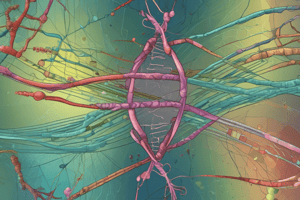Podcast
Questions and Answers
What do genes carry that is passed from one generation to the next?
What do genes carry that is passed from one generation to the next?
- Traits and characteristics (correct)
- Information about the environment
- Regulatory signals for growth
- Instructions for cellular energy production
What is the total number of chromosomes present in a normal human cell?
What is the total number of chromosomes present in a normal human cell?
- 46 (correct)
- 22
- 23
- 92
What determines the sex of a baby?
What determines the sex of a baby?
- Combined traits from both parents
- The father's sperm
- The 23rd pair of chromosomes (correct)
- The mother's egg
Which part of DNA is critical for the formation of genes?
Which part of DNA is critical for the formation of genes?
What is a genetic disorder?
What is a genetic disorder?
How many genes does a typical person have?
How many genes does a typical person have?
What are autosomes?
What are autosomes?
What do both the egg and sperm contribute to the baby?
What do both the egg and sperm contribute to the baby?
What type of microscope is needed to see genes?
What type of microscope is needed to see genes?
How can a child inherit a genetic disorder?
How can a child inherit a genetic disorder?
Flashcards are hidden until you start studying
Study Notes
What Is Genetics?
- Genetics is the study of genes and how they are inherited across generations.
- Genes influence traits such as hair color, eye color, and susceptibility to certain illnesses.
- They also determine biological sex and can explain familial health patterns.
What Are Genes?
- Genes are segments of DNA located within human cells, visible only with a powerful microscope.
- DNA consists of four types of chemicals that pair in various combinations, forming specific codes for genes.
- Humans have approximately 20,000 genes that dictate physical and biological characteristics.
What Is a Chromosome?
- Chromosomes are structures that tightly package DNA within each cell.
- Each normal human cell contains 23 pairs of chromosomes, totaling 46.
- Of these, 22 pairs are autosomes, which are identical in both males and females.
- The 23rd pair comprises sex chromosomes: females have two X chromosomes, males have one X and one Y chromosome.
How Do Genes Pass From Parent to Child?
- A fetus is formed when a mother’s egg and a father’s sperm combine, each contributing half of the chromosome set.
- Consequently, a child inherits half their DNA from their mother and half from their father.
- Inside cells, chromosomes unravel to reveal the DNA, which is structured as two connected strands with nucleotides.
What Is a Genetic Disorder?
- Genetic disorders occur when there is a malfunction in a gene or multiple genes, leading to health issues.
- These disorders can be inherited from one or both parents or arise spontaneously in the child.
How Do Genetic Disorders Happen?
- Genetic disorders can result from:
- A mutation in a single gene on a chromosome.
- A deletion of a portion of a chromosome.
- A translocation, which refers to genes relocating between chromosomes.
- An abnormal number of chromosomes, including extras or deficiencies in sex chromosomes.
Studying That Suits You
Use AI to generate personalized quizzes and flashcards to suit your learning preferences.




